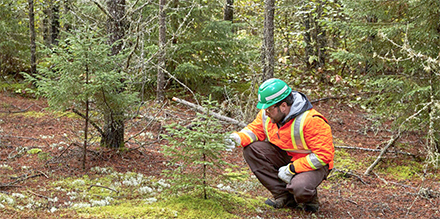Resolute’s primary input is trees – fortunately, a plentiful, renewable natural resource. Canada’s vast boreal forest supplies much of the wood that the company harvests to make its products. Here are 10 things to know about the boreal forests in Canada. Source: Timberbiz
Canada’s boreal forest is…
- Covering over 1.9 billion hectares, the boreal forest circles the entire northern hemisphere. Nearly a third (28%) of it is located in Canada, stretching from Yukon to Newfoundland-and-Labrador. About 75% of Canada’s 362 million hectares of forest is located in the boreal zone.
- Canada’s boreal forest is primarily populated by evergreen tree species – spruce, pine and fir. Other species such as white birch, poplar and Eastern white cedar can also be found there. And thousands of species of animals, birds, plants and insects thrive in its habitat – from hawks to hummingbirds, and from moose to muskrats.
- Less than 0.2% of Canada’s forests were harvested in 2020 – more than 30 times less than what is disturbed annually by natural causes such as forest fires, insects and disease. Canada’s deforestation rate, already among the world’s lowest, has been declining for over 25 years.
- About 90% of Canada’s forests are found on publicly owned land. Given the strong ties between Canadians and their forests, Canada has a strong commitment to sustainable forest management (SFM) – about 75% of Canada’s managed forest land is certified to third-party SFM standards.
- Although the boreal region itself is ancient, the boreal forest is made up mostly of trees that are relatively young compared with many that grow in more temperate climates. The boreal continually renews itself through forest fires, insects and other natural disturbances. Today’s harvesting practices in the boreal mimic these natural patterns.
- In forest terms, resilience refers to its ability to resist change or regenerate after a disturbance, while restoring its composition and structure. With its cyclical nature, Canada’s boreal forest is known for its high degree of resilience. Scientists, governments, industry and many others are working to ensure the boreal’s long-term resilience and health in a myriad of ways, from evolving management strategies to wildfire-monitoring satellites.
- The boreal sustains families, supports high-paying jobs and plays a lead role in the emerging circular economy. In fact, Canada’s forest sector supports more than 300 forest-reliant communities and is a direct source of employment for more than 184,000 people. Countless useful products are made from trees harvested in the boreal, through increasingly integrated and efficient operations – ensuring we maximize the value of each tree harvested. The Canadian forest sector is adapting, too, by investing in emerging technologies, diversifying through bioproducts and meeting the increasing demand for renewable energy.
- Canada’s boreal forest is among the best managed on earth, thanks to world-class and internationally recognized forest management policies. All commercial activity in Canada’s boreal adheres to stringent government environmental standards and regulations designed to promote healthy, sustainable forests – balancing environmental, social and economic values. For example, all forests harvested on public lands must be regenerated.
- As affirmed by the United Nations Intergovernmental Panel on Climate Change (IPCC), sustainable forest management play a key role in mitigating the impacts of climate change.
- The value of Canada’s boreal forest cannot be understated; it provides vital ecological services, socio-cultural and traditional values, economic benefits and products needed and used every day.






